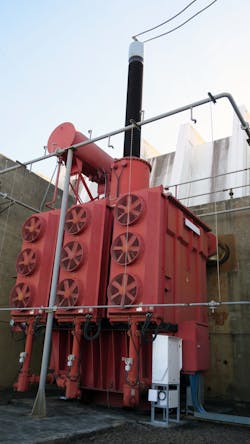Insulation liquids are crucial to the transmission and distribution of the electricity that powers our daily lives.
Due to recent carbon neutral initiatives, the utility industry has experienced a growing trend toward the use of alternative insulation liquids like synthetic esters in power transformers. Compared to traditional mineral oils, esters offer some advantages, including improved fire safety and biodegradability. In addition, synthetic esters also have very good oxidation stability. But as operators embrace these synthetic ester liquids, challenges in interpreting dissolved gas analysis (DGA) arise.
Understanding Synthetic Esters
A comprehensive understanding of different insulation liquids is important to help determine which option is best for a specific transformer.
Synthetic esters are a type of dielectric fluid specifically formulated for use in power transformers. Synthetically composed of organic compounds derived from the reaction between an alcohol and an organic acid with uniform molecular structure, these fluids offer a few advantages over mineral oil.
One of the primary benefits is enhanced fire safety. Synthetic esters have a significantly higher flash point, meaning they are much less flammable than mineral oil, even self-extinguishing. This greatly reduces the risk of transformer fires and enhances safety, particularly in high-density urban areas or installations near critical infrastructure.
While several types of synthetic esters are used in power transformers, the choice ultimately depends on factors like the specific requirements of the transformer, environmental considerations, compatibility with other insulation materials and financial impact.
Understanding synthetic esters drives informed decision-making and helps to ensure the optimal performance of the transformer. However, only a few standards are available for ester liquids, potentially making interpretation of DGA monitor data difficult.
The Need for Reliable DGA Measurements
Trustworthy DGA measurements provide a necessary indication of the reliability and health of power transformers, empowering utility professionals to detect and address potential issues before escalating into more severe problems.
However, synthetic esters, with their unique chemical composition, can present some challenges in measuring the gases and understanding their meaning. The gases formed in the case of a transformer fault are mainly the same as with mineral oils but with somewhat different levels and ratios. The solubility of those gases in ester liquids, on the other hand, is rather different than in mineral oils. This is very important to acknowledge in DGA monitoring — especially if head space gas extraction is used. Neglecting those differences in gas analysis can yield wildly incorrect results and hamper the effectiveness of online DGA, resulting in wrong conclusions on the transformer condition.
Challenges in Online DGA Monitoring
Online dissolved gas analysis is the most effective method for early fault detection, monitoring insulation degradation and identifying potential issues with transformers to ultimately prevent catastrophic failures. However, comprehensive interpretation of DGA results requires adapting existing techniques to account for the unique properties of synthetic esters.
The differences in the chemical structure of ester liquids and mineral oils lead to rather significant differences in how gases form. Gases produced by the different chemical processes happening during transformer faults have somewhat new meaning and affect the interpretation of DGA results. Typical in synthetic esters across all available data is, for example, that carbon monoxide tends to be relatively high compared to mineral oils. Since synthetic esters exhibit inherently higher CO levels, establishing a baseline for comparison is important to differentiate between normal, elevated CO levels and abnormal levels indicating potential issues with paper degradation. This means that the common methods used for fault diagnostics with data from mineral oil-filled transformers do not work properly for ester liquids. Some modifications for the diagnostics methods for mineral oils are needed to make them applicable to ester liquids. Such tools include the Duval Triangle and Pentagon for synthetic esters.
With synthetic esters, ensure your monitoring tool uses the Duval triangle 3 meant for synthetic esters or Pentagon 3 for proper fault diagnostics — there are no gas ratios for fault diagnostics by IEEE or IEC yet. Since the population is much smaller in the ester-filled transformers, the uncertainty of typical values provided for reference by IEEE standard C57.155 is also higher, so consider those with caution. This is a challenge addressed by international working groups, and there are many initiatives to collect more data for better reference for the industry to apply in the future.
As mentioned, solubility of gases can significantly affect online DGA measurement results, so use the correct monitor model that addresses the differences in gas solubilities between mineral oils and esters. Regarding higher viscosity of the ester liquids, consider piping insulation or trace heating in colder environments. Material compatibility can also impact the effectiveness of the DGA measurement, so — again — use a suitable model to ensure the gaskets and other materials are compatible with the esters. Finally, if you are changing a DGA monitor from one transformer to another location, verify the mixability of the insulating fluids if they are different.
Overcoming these challenges allows utility professionals to enhance transformer reliability, optimize maintenance strategies and prevent costly downtime.
Moving Forward with Synthetic Esters
As the utility industry increasingly adopts synthetic esters as insulation liquids for power transformers, understanding the unique properties and benefits is essential for informed decision-making. DGA monitoring plays a vital role in ensuring transformer reliability, and operators must address the challenges associated with the impact of synthetic esters. By acknowledging and mitigating these challenges, utility professionals can harness synthetic esters' advantages while monitoring transformer health most effectively.
Consider these valuable insights into the pros and cons of DGA monitoring of synthetic esters to make the most informed decision for your power transformers.
Senja Leivo is the senior industry expert at Vaisala. An active member of CIGRE working groups, she is an experienced professional in condition monitoring of power transformers with DGA and moisture monitoring. With 24 years of experience in international industrial businesses, she is responsible for identifying strategic trends and new monitoring needs within the power industry. Senja holds a Master of Science degree in Materials Engineering.



